Performance of the Compliant Foil Gas Seal with Surface Micro-Textured Top Foil
Abstract
:Featured Application
Abstract
1. Introduction
2. Materials and Methods
2.1. Geometric Model
2.2. Micro-Texture Model
3. Theoretical Model
3.1. Reynolds Equation and Gas Film Thickness Control Equation
3.2. Boundary Conditions
3.3. Static Sealing Performance Parameters
3.4. Dynamic Sealing Performance Parameters
3.5. Calculation Flow
3.6. Parameters Selection
3.7. Program Correctness Verification
4. Results
4.1. Distribution of the Gas Film Thickness and Gas Film Pressure



4.2. Analysis of the Static Characteristics
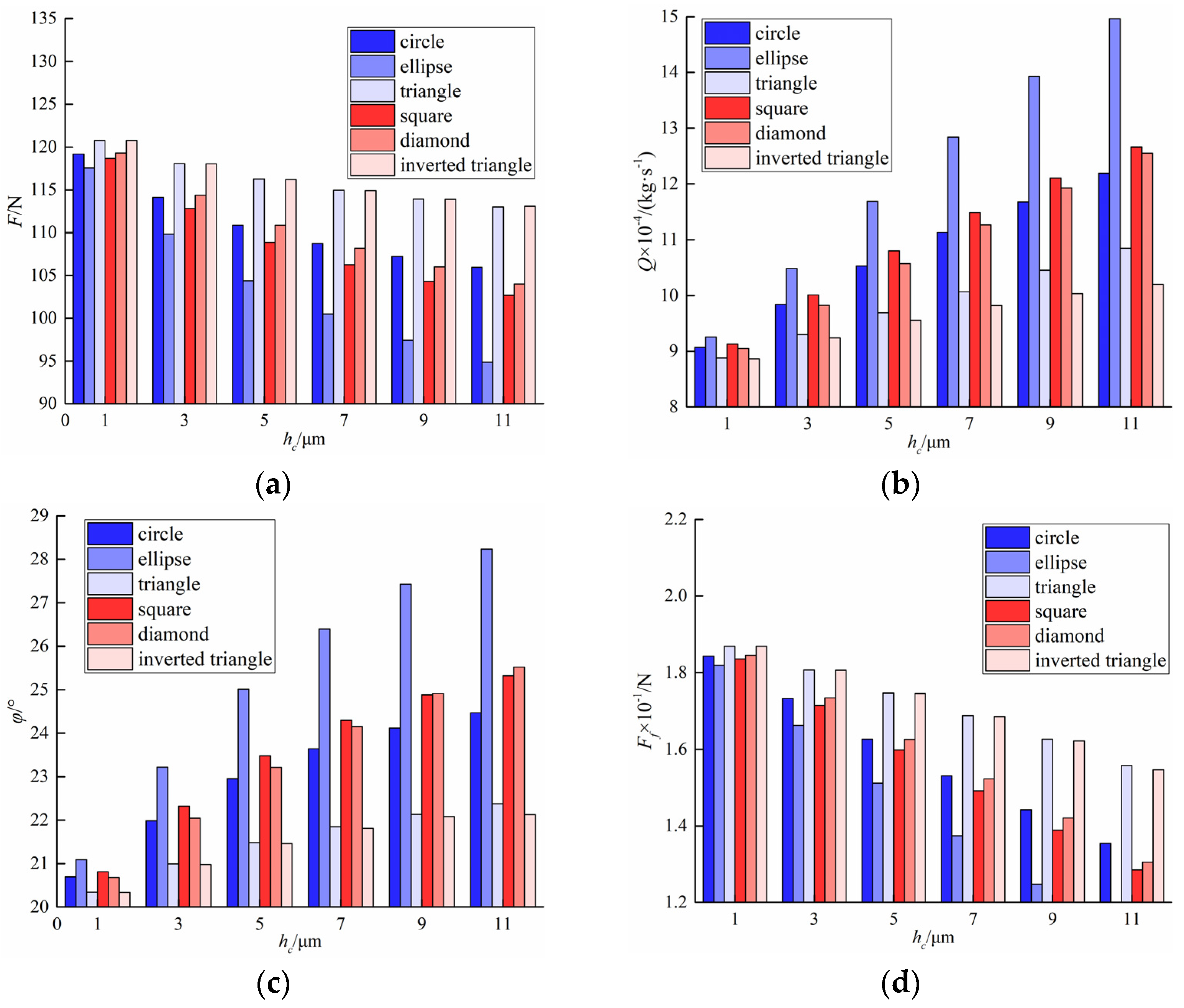
4.3. Analysis of the Dynamic Characteristics
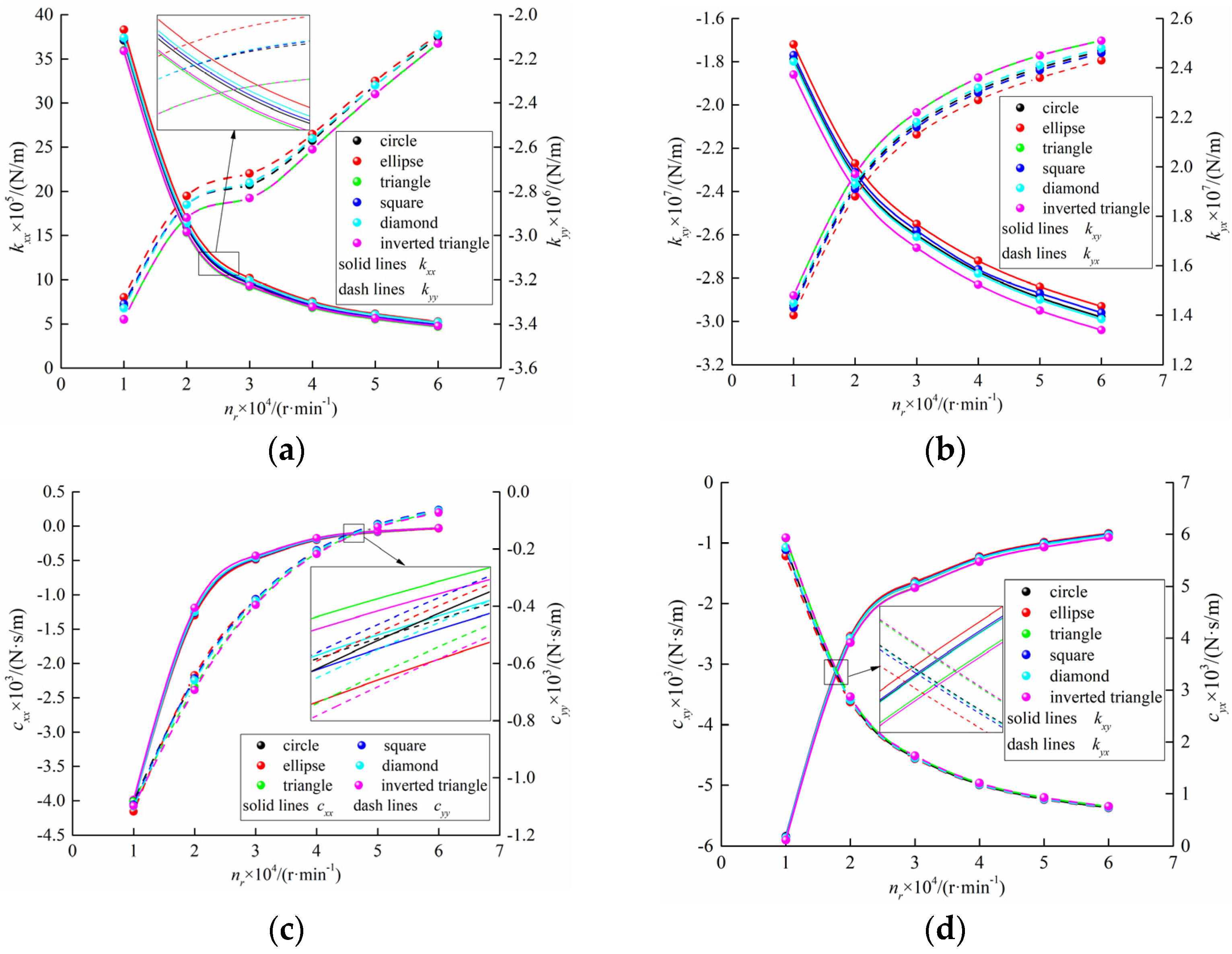
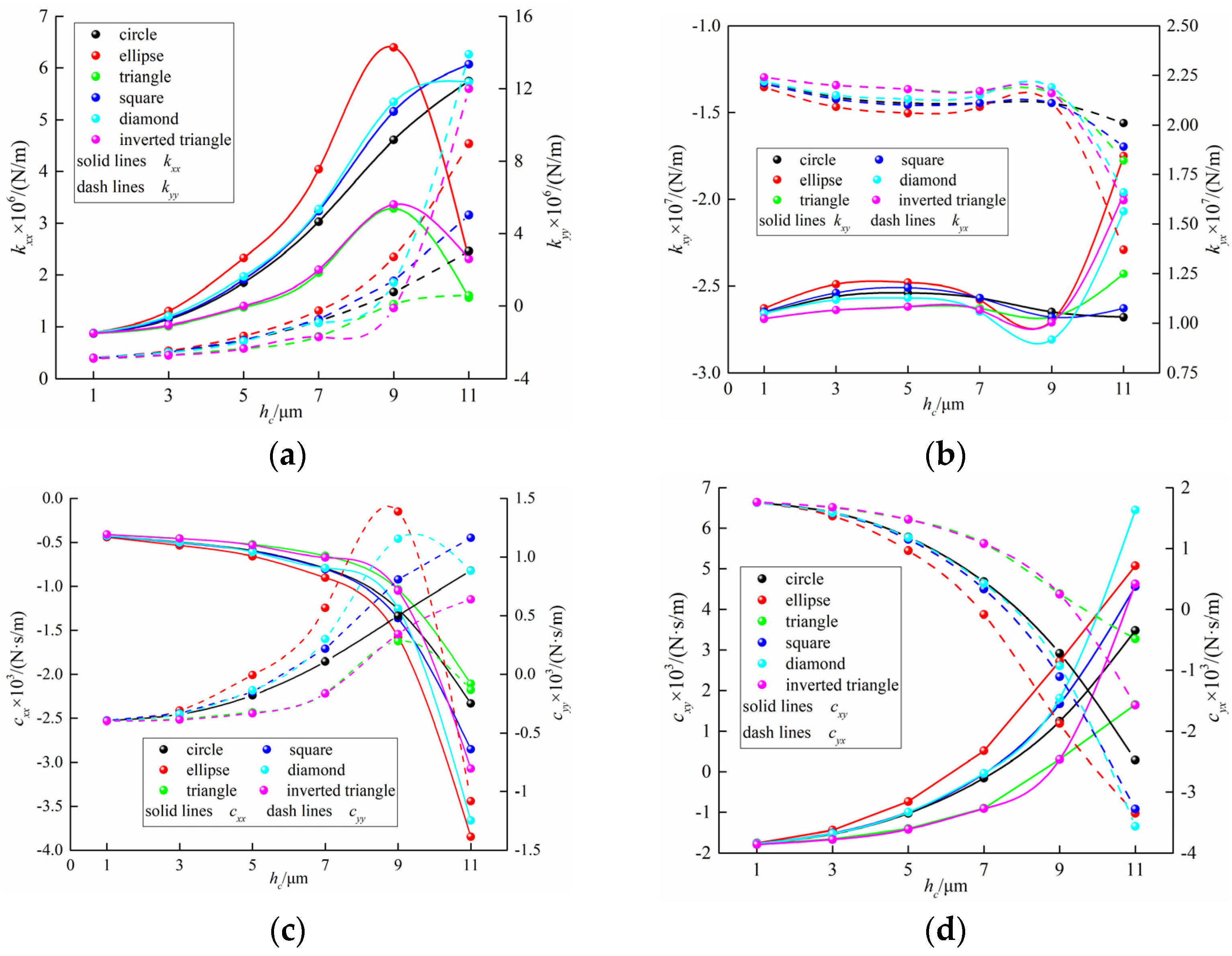
5. Discussion
6. Conclusions
- (1)
- Micro-textures machined on the surface of flat foil create local pressure rise regions within a stable flow field. Owing to the difference in the texture shape characteristics and directionality, the gas film thickness and pressure distribution of different compliant foil gas seals are different.
- (2)
- As the rotational speed increases, the force and the viscous friction force increase and the attitude angle decreases; however, the effect of the rotational speed on the mass leakage rate is negligible. Thus, the compliant foil gas seal shows good usability under low pressure and high-speed conditions.
- (3)
- Stiffness coefficients kxy and kyx and cross damping coefficients cxy and cyx are symmetrical. This reflects the circularity and quasi-symmetry of the flow field distribution as well as conform to the structural law of the compliant foil gas seal. Moreover, according to the dynamic parameters, the texture depth can be selected within the range of less than 9 μm to ensure stability.
- (4)
- Among the six typical texture shapes, the elliptical texture has the smallest gas film force and the largest mass leakage rate, which is the most unfavorable to the static sealing performance. The gas film force of the triangle and the inverted triangle are basically the same, but the inverted triangular texture can control the mass leakage rate and improve stability, thus showing the best comprehensive sealing performance.
Author Contributions
Funding
Institutional Review Board Statement
Acknowledgments
Conflicts of Interest
References
- Jiang, C.; Yin, C. Analysis on Aerodynamic Stability of Aero Gas Turbine Engine. Mech. Eng. Autom. 2021, 2, 182–184. [Google Scholar]
- Salehi, M.; Heshmat, H. On the Fluid Flow and Thermal Analysis of a Compliant Surface Foil Bearing and Seal. Tribol. Trans. 2000, 43, 318–324. [Google Scholar] [CrossRef]
- Lee, D.H.; Kim, Y.C.; Kim, K.W. The Effect of Coulomb Friction on the Static Performance of Foil Journal Bearings. Tribol. Int. 2010, 43, 1065–1072. [Google Scholar] [CrossRef]
- Song, J.H.; Kim, D.J. Foil Gas Bearing with Compression Springs: Analyses and Experiments. J. Tribol. 2007, 129, 628–639. [Google Scholar] [CrossRef]
- Wang, X.L.; Liu, M.H.; Sharon, K.W.; Hu, X.P. Numerical Evaluation of Rotor Dynamic Coefficients for Compliant Foil Gas Seal. Appl. Sci. 2020, 10, 9. [Google Scholar]
- Ma, G.; Xi, P.; Shen, X.M.; Hu, G.Y. Analysis of Quasi-dynamic Characteristics of Compliant Floating Ring Gas Cylinder Seal. J. Aerosp. Power 2010, 25, 1190–1196. [Google Scholar]
- Salehi, M.; Heshmat, H.; Walton, J. High Temperature Performance Evaluation of a Compliant Foil Seal. In Proceedings of the 36th AIAA/ASME/SAE/ASEE Joint Propulsion Conference & Exhibit, Huntsville, AL, USA, 17–19 July 2000. [Google Scholar]
- Salehi, M.; Heshmat, H. Performance of a Complaint Foil Seal in a Small Gas Turbine Engine Simulator Employing a Hybrid Foil/Ball Bearing Support System. Tribol. Trans. 2001, 44, 458–464. [Google Scholar] [CrossRef]
- Heshmat, H.; Walton, J. Innovative High-temperature Compliant Surface Foil Face Seal Development. In Proceedings of the 44th AIAA/ASME/SAE/ASEE Joint Propulsion Conference & Exhibit, Hartford, CT, USA, 21–23 July 2008. [Google Scholar]
- Salehi, M.; Heshmat, H. Analysis of a Compliant Gas Foil Seal with Turbulence Effects. In Proceedings of the 37th Joint Propulsion Conference and Exhibit, Salt Lake City, UT, USA, 8–11 July 2001. [Google Scholar]
- Kim, K.W.; Chung, J.T.; Kim, C.H.; Lee, Y.B. Theoretical Research of Static Characteristics of Bump Floating Ring Seal. J. Korean Soc. Tribol. Lubr. Eng. 2008, 24, 140–146. [Google Scholar]
- Lee, Y.B.; Kim, K.W.; Ryu, S.J. Leakage Performance and Rotordynamic Characteristics of Bump Floating Ring Seals for Turbopump. Am. Soc. Mech. Eng. 2014, 7B, 1–12. [Google Scholar]
- Ding, X.X.; He, Z.H.; Zhang, W.Z.; Lu, J.J.; Miao, C.H. Parameters Analysis of Steady Micro-scale Flow of Cylindrical Spiral Groove Dry Gas Seal. CIESC J. 2018, 69, 1537–1546. [Google Scholar]
- Wang, X.L.; Liu, M.H.; Xiong, Z.F.; Li, X. Turbulence Characteristics of Compliant Foil Gas Seal Considering Surface Roughness. CIESC J. 2022, 73, 1683–1694. [Google Scholar]
- Sahlin, F.; Glavatskih, S.B.; Almqvist, T.; Larsson, R. 2D CFD-Analysis of Micro-Patterned Surfaces in Hydrodynamic Lubrication. J. Tribol. 2004, 127, 1657–1665. [Google Scholar]
- Shi, L.; Wei, W.; Wang, T.; Zhang, Y.; Wang, X. Experimental Investigation of the Effect of Typical Surface Texture Patterns on Mechanical Seal Performance. J. Braz. Soc. Mech. Sci. Eng. 2020, 42, 227. [Google Scholar] [CrossRef]
- Stull, F.; Velkoff, H. Effects of Transverse Ribs on Pressure Recovery in Two-dimensional Subsonic Diffusers. In Proceedings of the Joint Propulsion Specialist Conference, Columbus, OH, USA, 29 November 1972. [Google Scholar]
- Mariotti, A.; Buresti, G.; Salvetti, M.V. Separation Delay through Contoured Transverse Grooves on a 2D Boat-tailed Bluff Body: Effects on Drag Reduction and Wake Flow Features. Eur. J. Mech.—B/Fluids 2018, 74, 351–362. [Google Scholar] [CrossRef]
- Liu, K.; Liu, Z.; Khan, A.M.; Chen, L.; Zhao, M. Effects of the Inclination Angles of DLC End Face Micro-texture on the Tribological Properties of Dry Gas Seal Rings. Surf. Topogr. Metrol. Prop. 2021, 9, 045014. [Google Scholar] [CrossRef]
- Chen, J.L.; Tang, L.P.; Ding, X.X.; Si, J.X.; Chen, D.L.; Sun, B.C. Frictional Vibration Performances of Dry Gas Seal Rings with DLC Film Textured Surface via Chaos Theory. Tribol. Trans. 2021, 64, 667–678. [Google Scholar] [CrossRef]
- Senatore, A.; Risitano, G.; Scappaticci, L.; D’Andrea, D. Investigation of the Tribological Properties of Different Textured Lead Bronze Coatings under Severe Load Conditions. Lubricants 2021, 9, 34. [Google Scholar] [CrossRef]
- Lang, A.W.; Jones, E.M.; Afroz, F. Separation Control over a Grooved Surface Inspired by Dolphin Skin. Bioinspiration Biomim. 2017, 12, 026005. [Google Scholar] [CrossRef]
- Bai, L.Q.; Zhang, P.C.; Khan, Z.A. Semi Salix Leaf Textured Gas Mechanical Face Seal with Enhanced Opening Performance. Materials 2021, 14, 7522. [Google Scholar] [CrossRef]
- Wu, Z.; Bao, H.; Xing, Y.Q.; Liu, L. Tribological Characteristics and Advanced Processing Methods of Textured Surfaces: A Review. Int. J. Adv. Manuf. Technol. 2021, 114, 1241–1277. [Google Scholar] [CrossRef]
- Ma, G.; Yang, W.R. Numerical Simulation and Parameter Optimization of Seal Property of Bidirectional Rotating Cylinder Gas Film. J. Beijing Univ. Aeronaut. Astronaut. 2016, 42, 2279–2288. [Google Scholar]
- Wang, T.; Liu, M.H.; Sun, J.F.; Dai, D. Simulation Analysis of the Sealing Performance of Cylinder Gas Film. Fluid Mach. 2020, 48, 55–60. [Google Scholar]
- Lu, J.J.; Zhang, W.; Ma, H. Floating Performance of Cylindrical Microgroove Gas Floating Seal Based on F-K Slip Flow Model. CIESC J. 2021, 72, 4267–4278. [Google Scholar]
- Iordanoff, I. Analysis of an Aerodynamic Compliant Foil Thrust Bearing: Method for a Rapid Design. ASME J. Tribol. 1999, 121, 816–822. [Google Scholar] [CrossRef]
- Chen, T.; Liu, M.H. Effects of Operating Parameters on the Seal Performance of Cylindrical Gas Film. Fluid Mach. 2014, 42, 43–46. [Google Scholar]
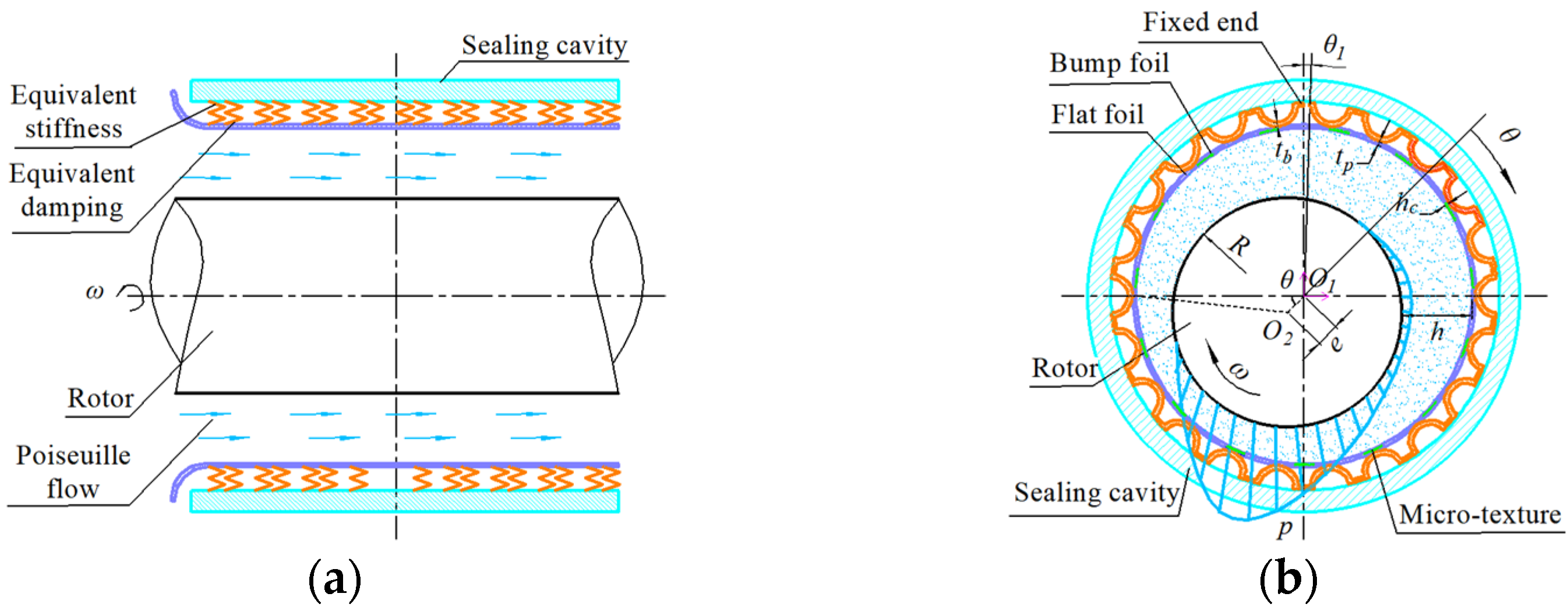
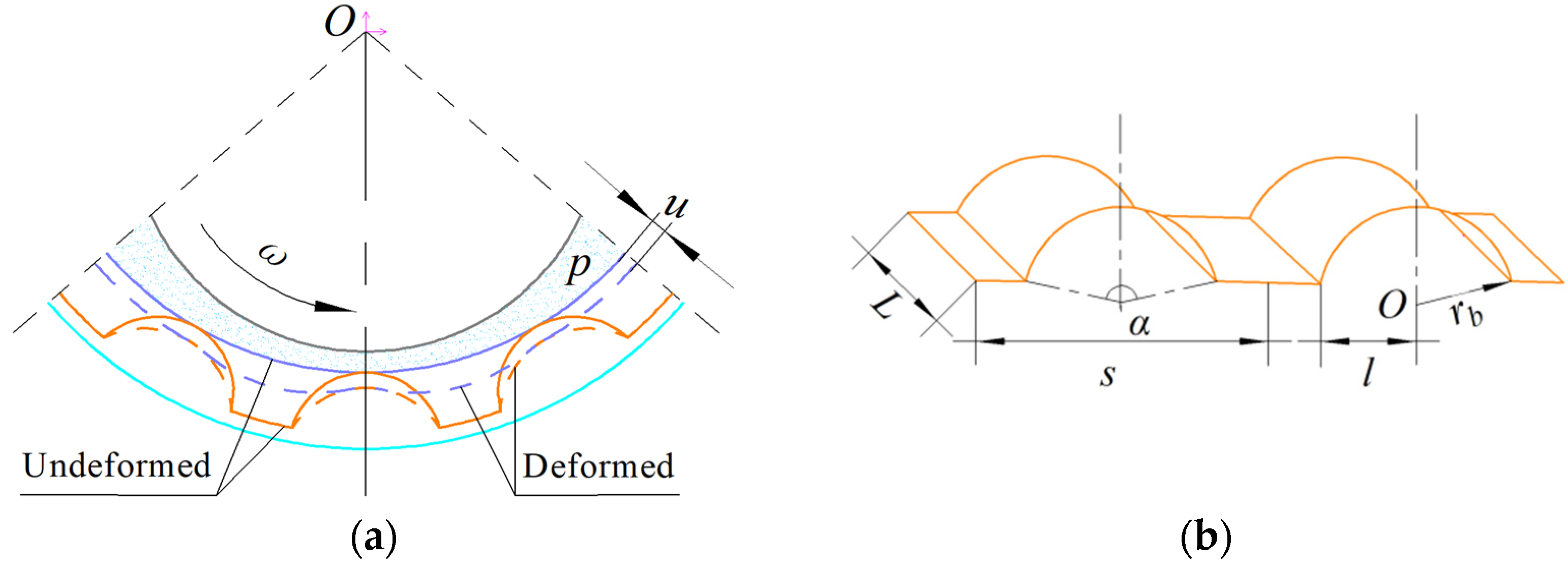
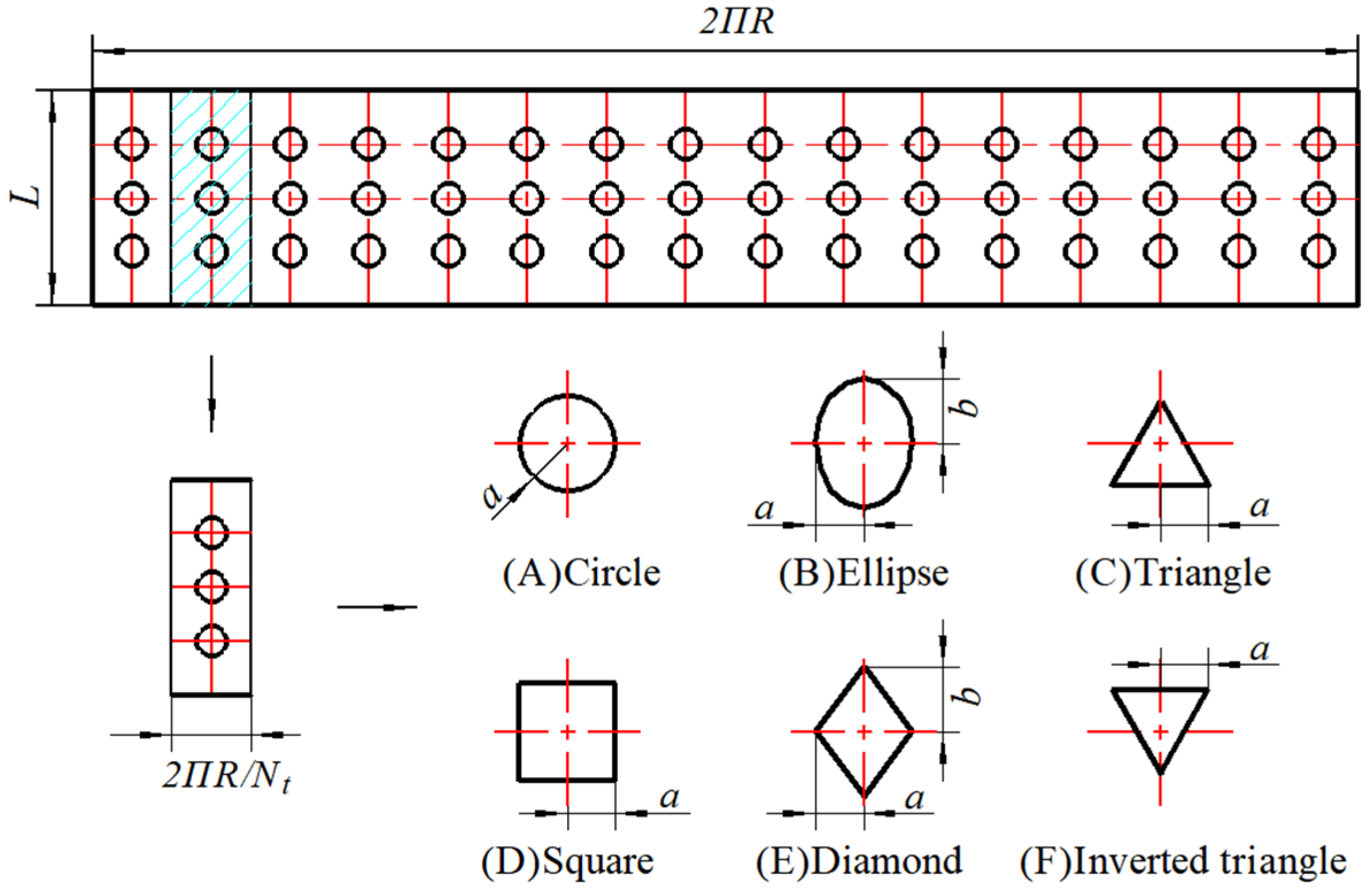
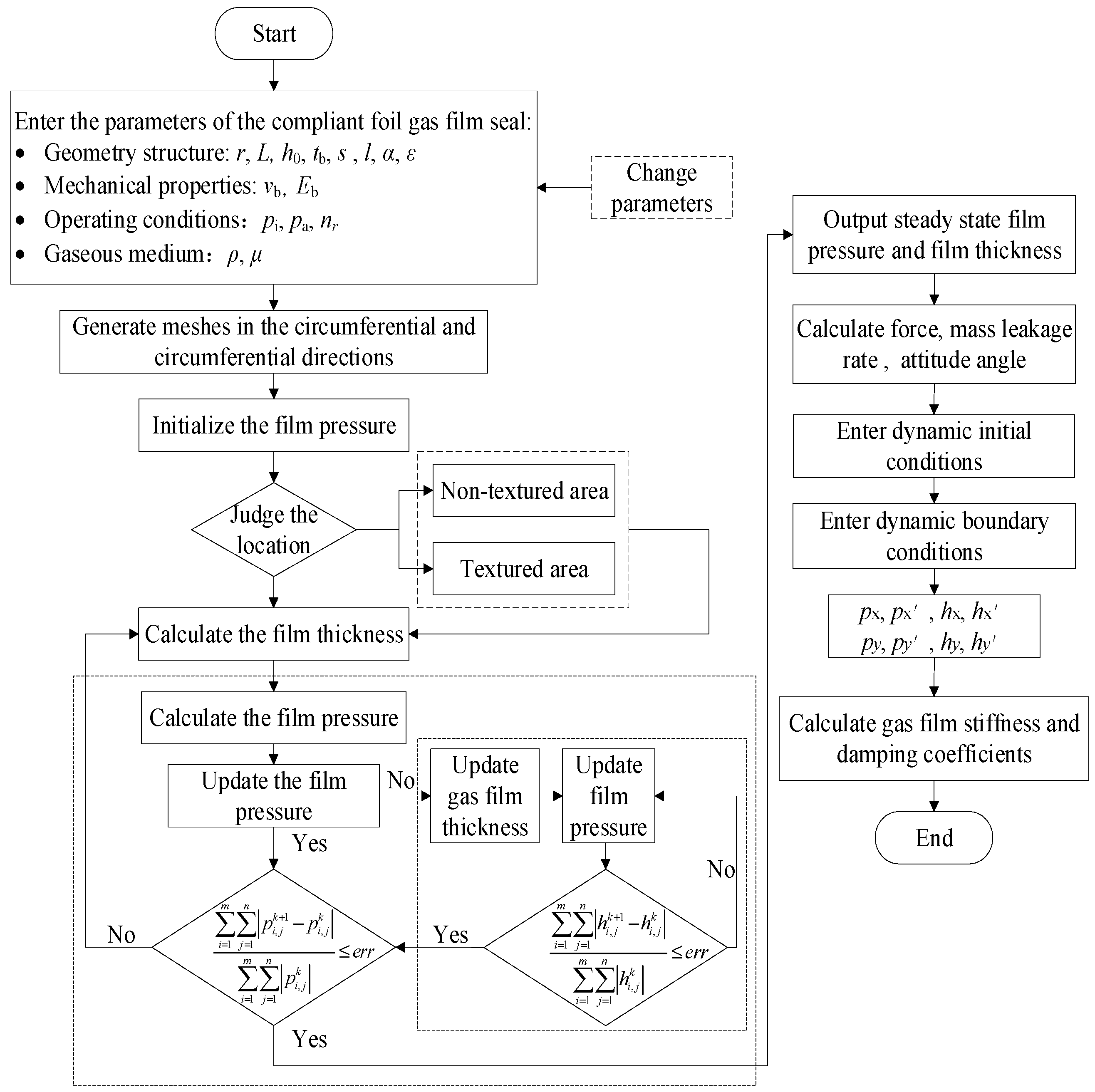
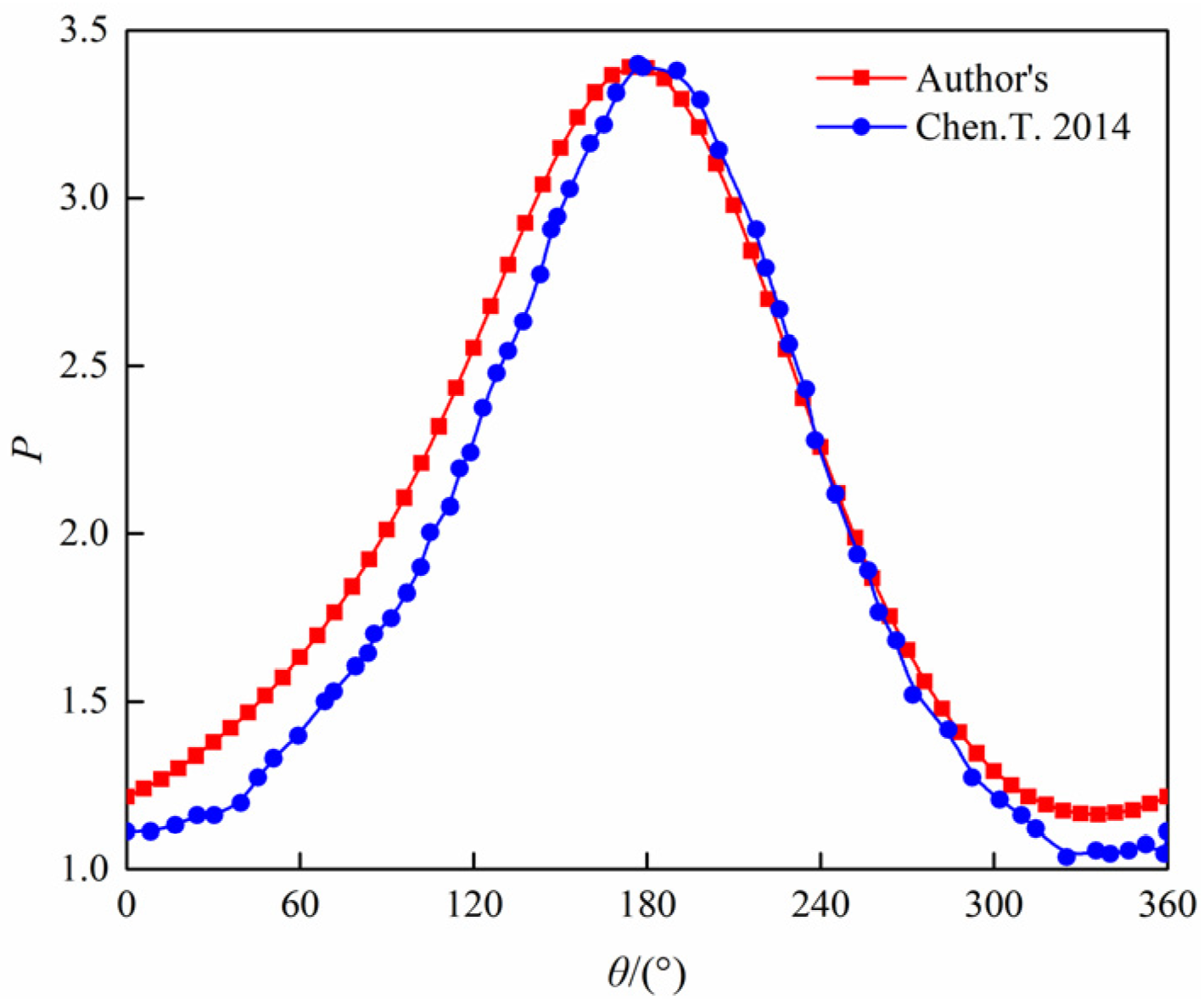
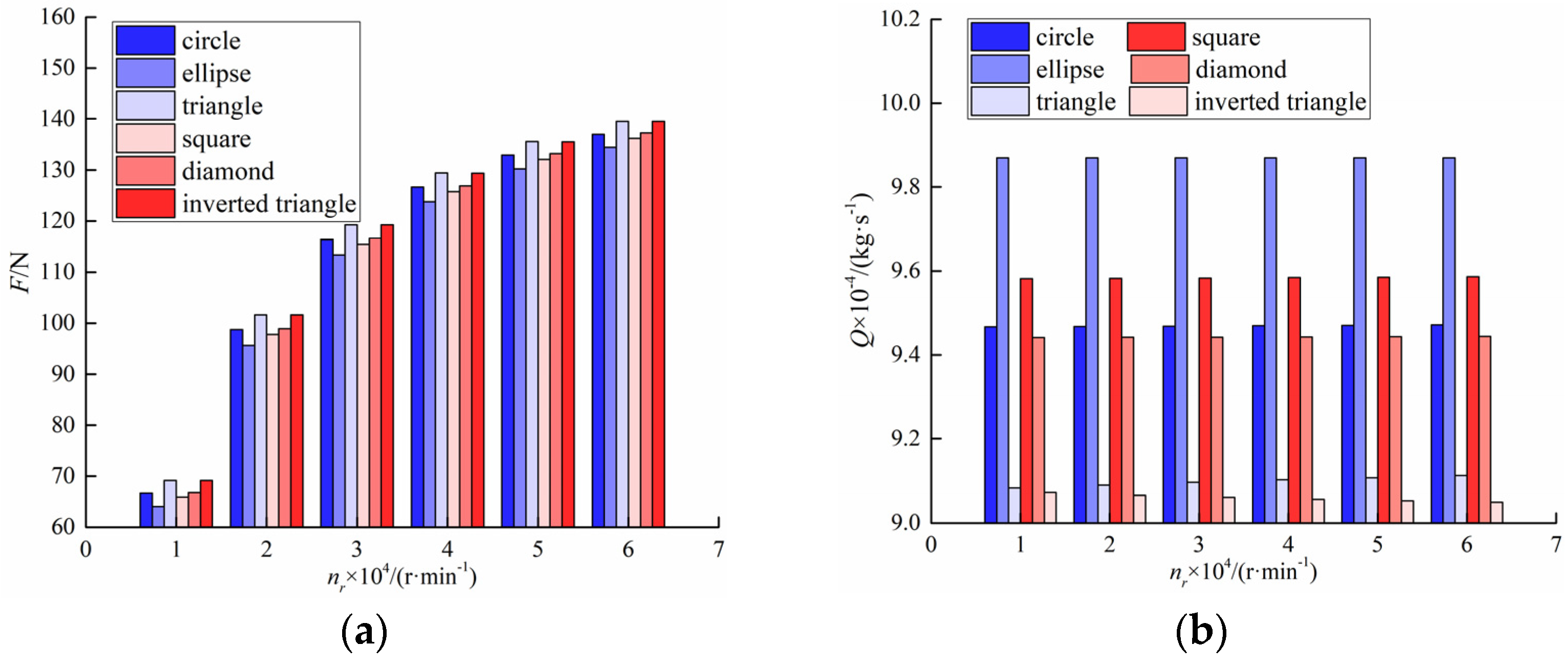
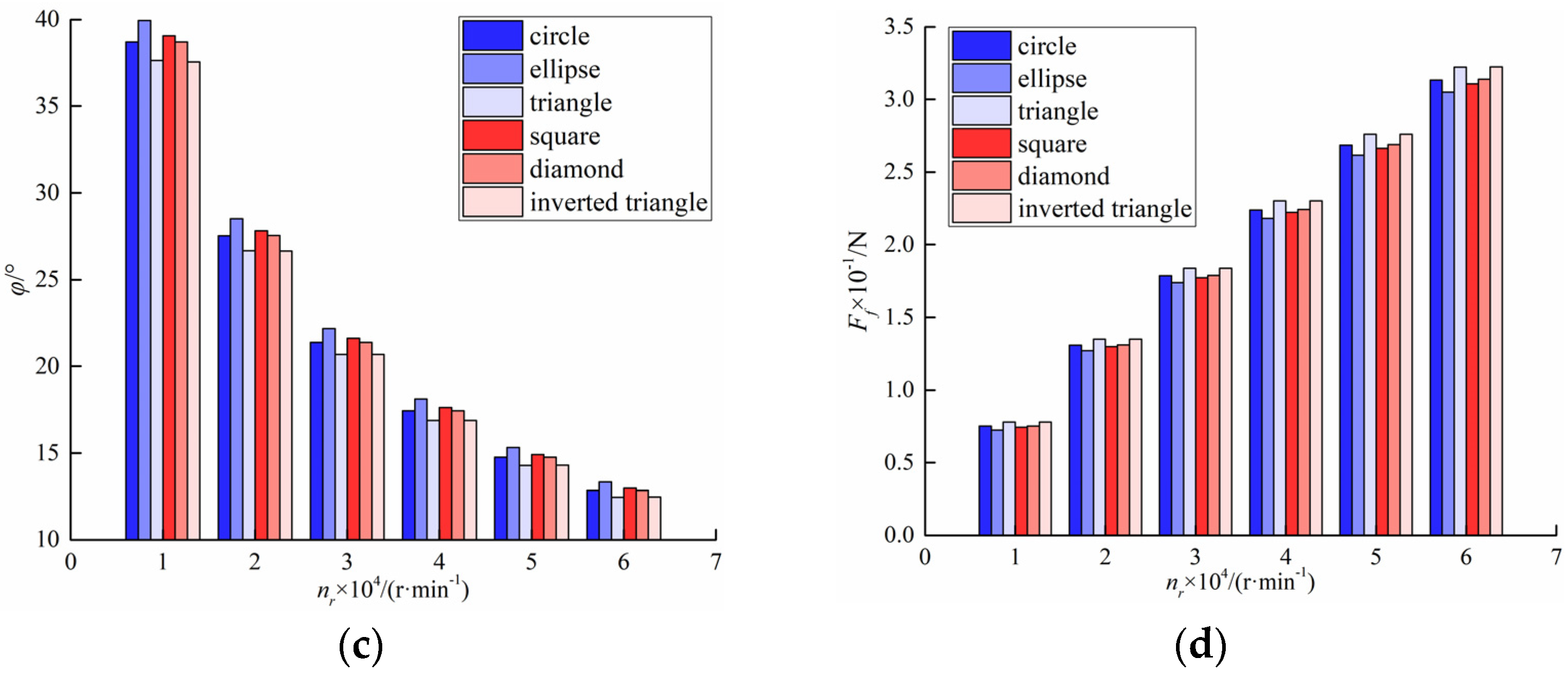
| Parameters | Values | Parameters | Values | Parameters | Values |
|---|---|---|---|---|---|
| R (mm) | 25 | a (mm) | 2 | rb (mm) | 3.365 |
| L (mm) | 26.67 | b (mm) | 3 | α (°) | 63.93 |
| Nt | 16 | tb (mm) | 0.2016 | vb | 0.3 |
| h0 (μm) | 10 | l (mm) | 1.778 | Eb (Pa) | 2.14 × 1011 |
| hc (μm) | 2 | s (mm) | 4.572 |
| Parameters | Values | Parameters | Values | Parameters | Values |
|---|---|---|---|---|---|
| pi (MPa) | 0.16 | μf | 0.1 | ρ (kg·m−3) | 1.1425 |
| po (MPa) | 0.101325 | nr (r·min−1) | 30,000 | μ (Pa·s) | 1.8 × 10−5 |
Publisher’s Note: MDPI stays neutral with regard to jurisdictional claims in published maps and institutional affiliations. |
© 2022 by the authors. Licensee MDPI, Basel, Switzerland. This article is an open access article distributed under the terms and conditions of the Creative Commons Attribution (CC BY) license (https://creativecommons.org/licenses/by/4.0/).
Share and Cite
Xu, J.; Yu, S.; Ding, X.; Jiang, H.; Li, L. Performance of the Compliant Foil Gas Seal with Surface Micro-Textured Top Foil. Appl. Sci. 2022, 12, 5633. https://doi.org/10.3390/app12115633
Xu J, Yu S, Ding X, Jiang H, Li L. Performance of the Compliant Foil Gas Seal with Surface Micro-Textured Top Foil. Applied Sciences. 2022; 12(11):5633. https://doi.org/10.3390/app12115633
Chicago/Turabian StyleXu, Jie, Shurong Yu, Xuexing Ding, Haitao Jiang, and Lu Li. 2022. "Performance of the Compliant Foil Gas Seal with Surface Micro-Textured Top Foil" Applied Sciences 12, no. 11: 5633. https://doi.org/10.3390/app12115633
APA StyleXu, J., Yu, S., Ding, X., Jiang, H., & Li, L. (2022). Performance of the Compliant Foil Gas Seal with Surface Micro-Textured Top Foil. Applied Sciences, 12(11), 5633. https://doi.org/10.3390/app12115633





